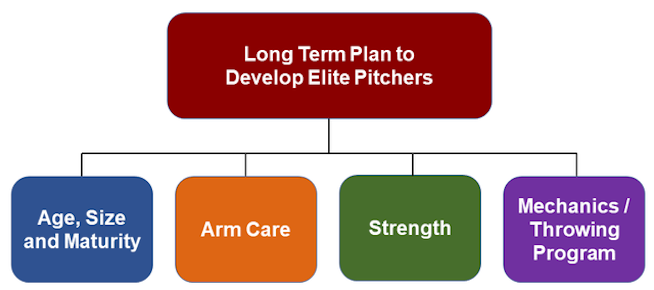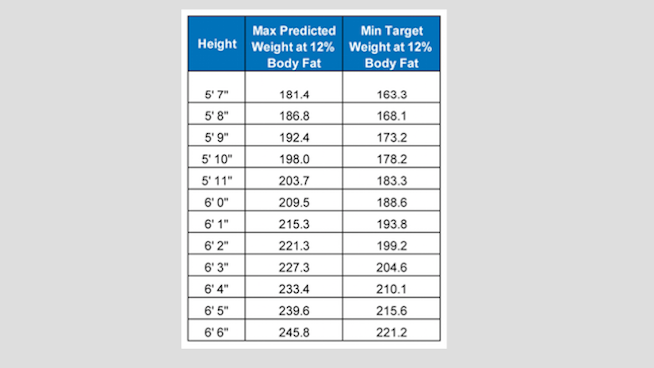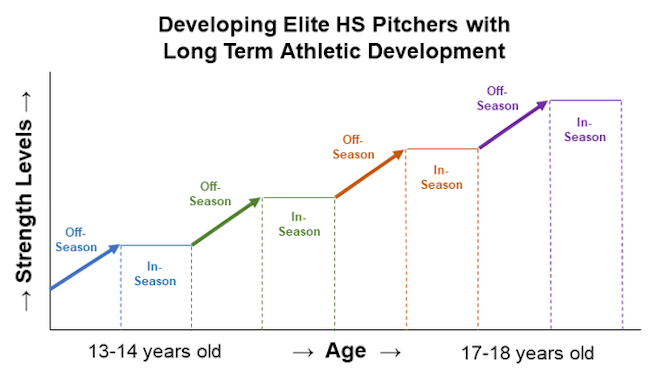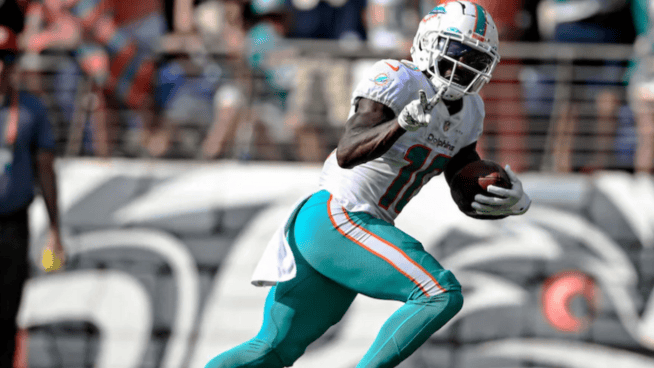4 Things That Every Young Pitcher Should Address
When looking at the most effective way to train young pitchers, we need to project out three or four years (or more) and consider the “long-term athletic development” (LTAD) of the athlete. We’re looking to build pitchers who can compete at a high level in high school and beyond, and long-term athletic development is the key to succeeding in this approach.
What is Long-Term Athletic Development?
LTAD is a training program based on the biological age of the athlete (meaning how mature their body is) as well as their chronological age (their age in years). It is athlete-, program- and, most importantly, coach-driven. Athletes who progress through an LTAD program experience training that considers their biological and training ages through periodized plans specific to their developmental and sport-specific needs. When planning out a pitcher’s LTAD, we need to focus on four big parameters:
- Age, size and maturity
- Arm care
- Strength and conditioning
- Mechanics/throwing program
Let’s look at each category, cleverly referred to by physical therapist Mike Reinold as “buckets,” a bit closer.

Bucket 1: Age, Size and Maturity
For every inch a young athlete grows, he gains approximately 1.5 mph in velocity (up to a certain point). As you get older and bigger, you’ll be able to throw harder. This effect can be amplified by a proper nutrition program designed to gain lean muscle mass. Increasing muscle size is directly related to how much force can be applied by an athlete, as well as how quickly they can apply that force. In other words, nothing will be a bigger boost to throwing harder than getting stronger by putting on more muscle! As a result, we often get highly motivated athletes coming into Rockland Peak Performance asking if a goal of gaining 5-10 pounds of lean muscle during their offseason is attainable. Our simple answer? Yes. But it’s all about nutrition and training. If you want to know where you stand with respect to your lean muscle mass, here’s a great reference for average weight ranges among young, high-level pitchers based on height (courtesy of Graeme Lehman):

If you’re not within 10-20 pounds of the minimum end of the above range for your height, you need to get in the gym and begin a nutrition plan with the goal of gaining weight. While such factors as height and limb length are primarily genetic and out of your control, putting on lean muscle mass is in your control and one of the easiest qualities to improve.
Bucket 2: Arm Care
Throwing makes you tight and tired. What to do: Get into a great progressive arm care program that includes:
- A Complete Movement Assessment – Any significant physical constraints that may negatively affect the athlete’s “movement strategy,” such as pain or extreme tightness, should be addressed prior to the start of an arm care/throwing program.
- Cuff Activation and Mobility – The importance here is that we ensure that each of the individual rotator cuff muscles are strong enough independently so that they can help contribute to overall shoulder health.
- Dynamic Cuff Stability – As a baseball player, you need the rotator cuff to dynamically stabilize the head of the humerus (arm) so that it stays in the glenoid fossa (socket). Not only do we need them to stabilize the humeral head, we need them to work on how quickly they do it. The bottom line is, even if you have strong cuff musculature, if those muscles fire slowly, your arm is still going to impinge and cause issues.
There’s a time and a place for everything. After a long season, clean yourself up rather than immediately enter into a velocity program!
Bucket 3: Strength and Conditioning
There should be three areas of long-term focus when it comes to a pitcher’s strength and conditioning program: the lower body (which produces power), the core (which transfers power), and the upper body/arm (which dissipates force and delivers the ball). That’s why pitchers need to get involved in a great strength program which addresses:
- Lower-Body Strength and Power
- Core Strength and Stability
- Linear and Rotational Power (Hip/Shoulder Separation)
- Total Athleticism – Dissipation and Re-direction of Force (Plyometrics/Speed)
The following chart provides a broad summary of how long-term development should unfold from season-to-season:

Ages 13-16 – This is the stage at which young athletes are physiologically the most responsive to stimuli and training. At this age, we should be focusing on the training of several motor abilities, such as strength, speed, hypertrophy and power development. They need to learn proper technique on the basic lifts (Squats, Deadlifts, pushing and pulling exercises) and only then is it appropriate to move on to power, speed and agility skills.
These athletes will train in every phase of the strength speed continuum (which I explain in greater detail in this piece) at the same time. This will help us produce a more “multi-faceted” athlete from an overall development standpoint. The real art here is giving the athletes what they want, as well as what they actually need.
Ages 16-18 – We implement skill training more specific to the sport only after the athlete has achieved success in all of the foundational movement skills. Because of the competitive nature at this age, training is intensified, so high-volume and high-intensity training begins to occur year-round. We recommend training three to five days/week to give athletes the best chance to succeed at the highest levels. They don’t need to be peaked for any individual event. Rather, they need to be ready to perform for periods of greater than half the calendar year. Our high school ball players are playing around 40-50 games, or more.
Note: As the offseason progresses, a pitcher’s throwing program begins to become the primary focus of his training. Scaling back the volume of his strength training program accordingly is paramount to avoid over-training once throwing begins.
Bucket 4 : Mechanics/Throwing Program
Creating an effective mechanics/throwing program entails regularly working to optimize your mechanics and developing a “year-round” throwing schedule. The program should address mechanics as well as incorporate them into a total throwing program schedule (which outlines both throwing and when time needs to be taken off from throwing). Bucket four can be viewed in three components: delivery and mechanics, the point of release and, a well thought-out throwing schedule.
Diving into delivery and Mechanics, here’s a short summary of the most important biomechanical factors needed to throw hard:
- Lower Half Engagement
- Hip/Shoulder Separation
- Stride Length
- Glove Side Integrity
- Finish (deceleration)
Now let’s talk a bit about the point of release. Not long ago, I heard someone say that “data talks to you.” Well, it’s true. It does. You just have to listen and know how to interpret what it’s saying. The introduction of devices like the Rapsodo camera system (which I outline in greater detail here) and the related data analytics are bringing a new and important focus to the point of release. Here, RPP pitching coach Robbie Aviles explains just another way spin rate can help create a more effective pitcher.
As for the design of the throwing program, here’s a sample year-round throwing schedule (8 months/year with 3-4 months off):
- Dec.14 – March 1 – Bullpens
- March 1 – June 1 – School Season
- June 1 – Aug 1 – Summer Ball/Velo Program
- Aug 1 – Dec. 14 – Offseason
Note: low-volume fielding positions and light catch do not count as “throwing.”
To recap, trainers and coaches need to educate themselves with respect to working with kids during sensitive periods of puberty and learn to think of their development as a “long-term” process. Remember, you’re not training adults!
If you address these four buckets and do it in a passionate manner, you’ll get greater “buy-in” from your athletes. To summarize, here are the four most important factors in a pitcher’s long-term development:
- Take part in a good nutrition program with the aim of gaining lean muscle mass
- Reduce overall stress (arm care, manual therapy)
- Maximize your overall potential and athleticism (strength training)
- Increase your efficiency and monitor your volume (mechanics / throwing program)
Don’t take shortcuts!
Photo Credit: Sidekick/iStock
READ MORE:
RECOMMENDED FOR YOU
MOST POPULAR
4 Things That Every Young Pitcher Should Address
When looking at the most effective way to train young pitchers, we need to project out three or four years (or more) and consider the “long-term athletic development” (LTAD) of the athlete. We’re looking to build pitchers who can compete at a high level in high school and beyond, and long-term athletic development is the key to succeeding in this approach.
What is Long-Term Athletic Development?
LTAD is a training program based on the biological age of the athlete (meaning how mature their body is) as well as their chronological age (their age in years). It is athlete-, program- and, most importantly, coach-driven. Athletes who progress through an LTAD program experience training that considers their biological and training ages through periodized plans specific to their developmental and sport-specific needs. When planning out a pitcher’s LTAD, we need to focus on four big parameters:
- Age, size and maturity
- Arm care
- Strength and conditioning
- Mechanics/throwing program
Let’s look at each category, cleverly referred to by physical therapist Mike Reinold as “buckets,” a bit closer.

Bucket 1: Age, Size and Maturity
For every inch a young athlete grows, he gains approximately 1.5 mph in velocity (up to a certain point). As you get older and bigger, you’ll be able to throw harder. This effect can be amplified by a proper nutrition program designed to gain lean muscle mass. Increasing muscle size is directly related to how much force can be applied by an athlete, as well as how quickly they can apply that force. In other words, nothing will be a bigger boost to throwing harder than getting stronger by putting on more muscle! As a result, we often get highly motivated athletes coming into Rockland Peak Performance asking if a goal of gaining 5-10 pounds of lean muscle during their offseason is attainable. Our simple answer? Yes. But it’s all about nutrition and training. If you want to know where you stand with respect to your lean muscle mass, here’s a great reference for average weight ranges among young, high-level pitchers based on height (courtesy of Graeme Lehman):

If you’re not within 10-20 pounds of the minimum end of the above range for your height, you need to get in the gym and begin a nutrition plan with the goal of gaining weight. While such factors as height and limb length are primarily genetic and out of your control, putting on lean muscle mass is in your control and one of the easiest qualities to improve.
Bucket 2: Arm Care
Throwing makes you tight and tired. What to do: Get into a great progressive arm care program that includes:
- A Complete Movement Assessment – Any significant physical constraints that may negatively affect the athlete’s “movement strategy,” such as pain or extreme tightness, should be addressed prior to the start of an arm care/throwing program.
- Cuff Activation and Mobility – The importance here is that we ensure that each of the individual rotator cuff muscles are strong enough independently so that they can help contribute to overall shoulder health.
- Dynamic Cuff Stability – As a baseball player, you need the rotator cuff to dynamically stabilize the head of the humerus (arm) so that it stays in the glenoid fossa (socket). Not only do we need them to stabilize the humeral head, we need them to work on how quickly they do it. The bottom line is, even if you have strong cuff musculature, if those muscles fire slowly, your arm is still going to impinge and cause issues.
There’s a time and a place for everything. After a long season, clean yourself up rather than immediately enter into a velocity program!
Bucket 3: Strength and Conditioning
There should be three areas of long-term focus when it comes to a pitcher’s strength and conditioning program: the lower body (which produces power), the core (which transfers power), and the upper body/arm (which dissipates force and delivers the ball). That’s why pitchers need to get involved in a great strength program which addresses:
- Lower-Body Strength and Power
- Core Strength and Stability
- Linear and Rotational Power (Hip/Shoulder Separation)
- Total Athleticism – Dissipation and Re-direction of Force (Plyometrics/Speed)
The following chart provides a broad summary of how long-term development should unfold from season-to-season:

Ages 13-16 – This is the stage at which young athletes are physiologically the most responsive to stimuli and training. At this age, we should be focusing on the training of several motor abilities, such as strength, speed, hypertrophy and power development. They need to learn proper technique on the basic lifts (Squats, Deadlifts, pushing and pulling exercises) and only then is it appropriate to move on to power, speed and agility skills.
These athletes will train in every phase of the strength speed continuum (which I explain in greater detail in this piece) at the same time. This will help us produce a more “multi-faceted” athlete from an overall development standpoint. The real art here is giving the athletes what they want, as well as what they actually need.
Ages 16-18 – We implement skill training more specific to the sport only after the athlete has achieved success in all of the foundational movement skills. Because of the competitive nature at this age, training is intensified, so high-volume and high-intensity training begins to occur year-round. We recommend training three to five days/week to give athletes the best chance to succeed at the highest levels. They don’t need to be peaked for any individual event. Rather, they need to be ready to perform for periods of greater than half the calendar year. Our high school ball players are playing around 40-50 games, or more.
Note: As the offseason progresses, a pitcher’s throwing program begins to become the primary focus of his training. Scaling back the volume of his strength training program accordingly is paramount to avoid over-training once throwing begins.
Bucket 4 : Mechanics/Throwing Program
Creating an effective mechanics/throwing program entails regularly working to optimize your mechanics and developing a “year-round” throwing schedule. The program should address mechanics as well as incorporate them into a total throwing program schedule (which outlines both throwing and when time needs to be taken off from throwing). Bucket four can be viewed in three components: delivery and mechanics, the point of release and, a well thought-out throwing schedule.
Diving into delivery and Mechanics, here’s a short summary of the most important biomechanical factors needed to throw hard:
- Lower Half Engagement
- Hip/Shoulder Separation
- Stride Length
- Glove Side Integrity
- Finish (deceleration)
Now let’s talk a bit about the point of release. Not long ago, I heard someone say that “data talks to you.” Well, it’s true. It does. You just have to listen and know how to interpret what it’s saying. The introduction of devices like the Rapsodo camera system (which I outline in greater detail here) and the related data analytics are bringing a new and important focus to the point of release. Here, RPP pitching coach Robbie Aviles explains just another way spin rate can help create a more effective pitcher.
As for the design of the throwing program, here’s a sample year-round throwing schedule (8 months/year with 3-4 months off):
- Dec.14 – March 1 – Bullpens
- March 1 – June 1 – School Season
- June 1 – Aug 1 – Summer Ball/Velo Program
- Aug 1 – Dec. 14 – Offseason
Note: low-volume fielding positions and light catch do not count as “throwing.”
To recap, trainers and coaches need to educate themselves with respect to working with kids during sensitive periods of puberty and learn to think of their development as a “long-term” process. Remember, you’re not training adults!
If you address these four buckets and do it in a passionate manner, you’ll get greater “buy-in” from your athletes. To summarize, here are the four most important factors in a pitcher’s long-term development:
- Take part in a good nutrition program with the aim of gaining lean muscle mass
- Reduce overall stress (arm care, manual therapy)
- Maximize your overall potential and athleticism (strength training)
- Increase your efficiency and monitor your volume (mechanics / throwing program)
Don’t take shortcuts!
Photo Credit: Sidekick/iStock
READ MORE:












